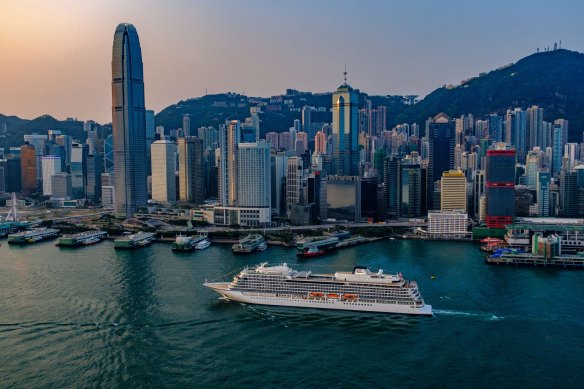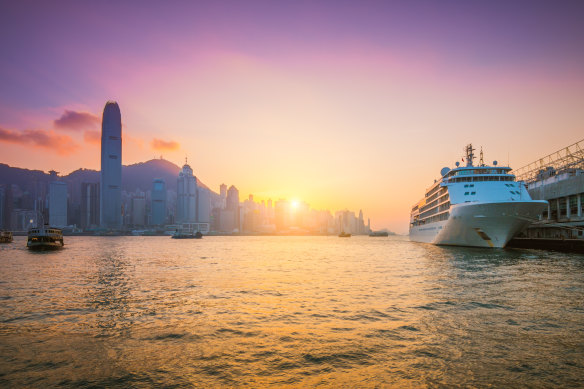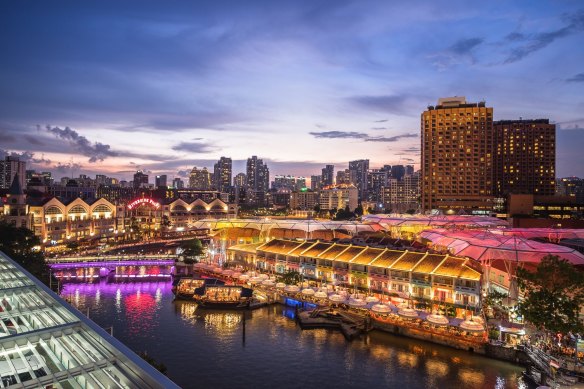The cruise industry’s Asia boom will have (delicious) benefits
Observant travellers might have noted new faces, conversations in new languages, and the appearance of standard buffet dishes such as congee and soup noodles on cruise ships of late. If you haven’t noticed, you soon will, because the Asian cruise market is booming.
Asia was the third-largest source market for cruise lines in 2022, although its 3,738,000 passengers amounted to only 15 per cent of the total. But that number is expected to have a compound annual growth rate of 12.5 per cent every year until 2030.

The Viking Sun cruising Victoria Harbour, Hong Kong.
And while many Asian cruise passengers have previously confined themselves to budget short cruises close to home, you should increasingly expect them aboard ships everywhere as demand soars for luxury ships, longer cruises, and increasingly distant destinations.
Western cruise brands have long seen the potential of the emerging Asian market. Lines such as Holland America, MSC, Princess Cruises, Silversea, Royal Caribbean and Viking have a significant presence in Asia, and some homeport ships in cities such as Hong Kong, Shanghai and Shenzhen.
But competition is hotting up as domestic cruise lines emerge, among them Cordelia Cruises and Jalesh Cruises in India, Resorts World Cruises in Singapore, and Adora Cruises in China.
The latter’s launch of Adora Magic City in Shanghai in January was a milestone for China’s cruise ambitions, since it’s the first large cruise ship built in China.

Rhe number of ships arriving in Hong Kong this year is expected to jump 50 per cent.Credit: iStock
With 3.25 million passengers annually, Shanghai is now Asia’s busiest cruise port and the sixth-busiest port in the world. Singapore is following in its wake, and Hong Kong is keen to rope in more business: the number of ships arriving in Hong Kong this year is expected to jump 50 per cent.
Entirely new cruise ports are emerging. Benoa is being developed as Bali’s second cruise port, with a capacity to process 15,000 passengers daily by 2028. Further Indonesian cruise ports are under way at Tanjung Pinang on Bintan Island just off Singapore, and on Ambon in the Maluku or Spice Islands.
Malaysia is improving port facilities at Port Klang and Penang. Next month, Seosan in South Korea will welcome its first cruise ship. South Korea plans to lure 1.5 million cruise passengers by 2027.
Meanwhile Tianjin in China is expected to see 100 cruise ships call in this year. This is remarkable considering that, in 2017, only 66 cruise ships operated itineraries in all Asia.

Singapore recently overtook Australia and America for cruise market penetration.Credit: Getty Images
Singapore recently overtook Australia and America to reach the top of the league for market penetration, but that number is just seven per cent, so there’s clearly vast potential for further growth across Asia.
China, Hong Kong, Vietnam, the Philippines and India are all tipped as big source markets. India alone will provide a million cruise passengers annually by 2027, according to some predictions. Good news for those over the bacon and eggs: dosa, paratha and masala omelettes might be coming to your ship’s breakfast buffet soon.
EVERYONE ASKS
What are knots and nautical miles?
Every cruise passenger enjoying a day at sea expects the captain to make a midday announcement regarding the ship’s location and speed, but most of us remain baffled by the measurements he or she uses.
A nautical mile is slightly longer than a land-based mile, to be exact 1.1508 miles or 1.852 kilometres. The reason for the difference is that sailors (and airline pilots) use latitude and longitude as co-ordinates, as these take into account the Earth’s curvature, which becomes important over long distances.
An international nautical mile is one minute of latitude and, miraculously, is a measurement the whole world agrees upon, including the United States and United Kingdom. There’s no such thing as a nautical kilometre.
Knots measure speed, with one knot the equivalent of one nautical mile per hour, or 1.852 kilometres an hour. It derives its name from the knotted ropes once used by mariners, which they let out behind their ships to estimate speed.
Fortunately, cruise-ship captains tell you the water depth in metres. The older measurement is the fathom, originally the span of a sailor’s outstretched arms, now six feet or 1.8288 metres. It isn’t a recognised international standard, and only the United States continues to use it on nautical charts.
NUMBER
1,181,953
Annual cruise passengers passing through Singapore in 2022, according to the Singapore Tourism Board, making it Asia’s second-busiest cruise port.
Sign up for the Traveller newsletter
The latest travel news, tips and inspiration delivered to your inbox. Sign up now.